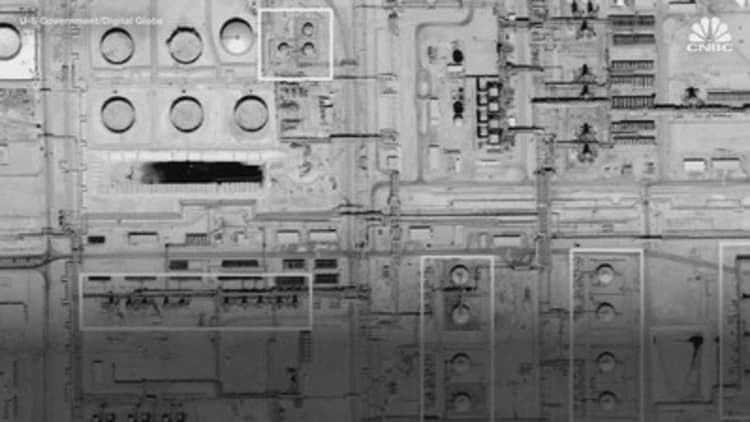
DUBAI — Satellite photos released by the U.S. government and DigitalGlobe reveal the surgical precision with which Saudi Aramco's oil facilities were struck in attacks early Saturday.
The strikes, which unidentified U.S. officials have said involved at least 20 drones and several cruise missiles, forced Saudi Arabia to shut down half its oil production capacity, or 5.7 million barrels per day of crude — 5% of the world's global daily oil production.
The images, first obtained by The Associated Press, show that at least 19 strikes were launched and 17 actually hit targets.
The attacks were "extremely surgical," Samir Madani, co-founder of satellite tracking firm TankerTrackers.com, told CNBC on Monday. Analysts have identified at least 17 hits, which targeted 14 storage tanks and three processing trains. "Those punctured tanks — same position on all of them," Madani said.
Photos show hits on several "spheroids" used to process crude oil, which analysts say reveal pinpoint accuracy. The images also reveal fires from blasts elsewhere in the facility.
Damage to the top OPEC producer's oil installations ignited fears of supply disruption around the world and has sent crude prices soaring by double digits.
Saudi Arabia's Abqaiq facility in its eastern province is the world's largest crude oil stabilization plant, with a processing capacity of more than 7 million bpd. Its Khurais oilfield, which was also hit, is the kingdom's second-largest with a capacity to pump around 1.5 million bpd.
Saturday's attack is the biggest on Saudi oil infrastructure since Saddam Hussein's invasion of Kuwait in 1990, when the Iraqi military fired Scud missiles into the kingdom.
Yemen's Houthi rebels claimed responsibility the attack, but U.S. Secretary of State Mike Pompeo has labeled Iran as the culprit, a claim Tehran denies as "unacceptable" and "pointless." The Saudi-led coalition fighting the Houthis announced Monday that preliminary results of an investigation indicated that the weapons used are Iranian and were not launched from Yemen.
Madani's analysis found that the strikes came from a west-north-west direction, which is consistent with that of U.S. officials. Houthi-controlled territory in Yemen, by contrast, is located to the southwest of the facilities.
Coalition spokesman Col. Turki al-Maliki said investigators were still trying to determine the launch location.
"It's a bit alarming that these folks got through. We looked at those photos that were released by the Trump administration — they were exquisitely precise, they knew exactly what to hit, they hit it perfectly," Bob McNally, founder and president of consultancy Rapidan Energy Group, told CNBC's "Squawk Box Asia" on Tuesday.
Saudi Aramco President and CEO Amin Nasser said no one was hurt in the attacks and that emergency crews had contained the fires and brought the situation under control within hours. The kingdom's energy ministry is expected to announce the status and timeline for recovering its production capacity on Tuesday evening.
Ground scarring at the Khurais facility, which lies about 110 miles southwest of Abqaiq, indicates significant fire damage as well as strikes to two towers.
Anthony Cordesman of the Center for Strategic and International Studies on Monday cited anonymous U.S. experts who said that "there were more strikes than this that did not come as close to the target, and the strikes involved at least some cruise missiles as well as drones or were all cruise missiles."


